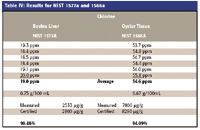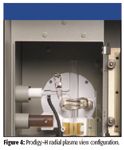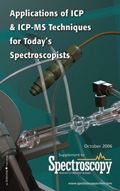Determination of the Halogen Elements in Aqueous, Organic, and Solid Samples Using ICP-OES
Accurate determination of trace Cl, Br, and I is important in industries such as petrochemical refining, chemical manufacturing, biomedical and nutritional supplement manufacturing, and environmental analysis. Until recently, it was thought that the halogen elements could not be determined effectively by inductively coupled plasma–optical emission spectroscopy (ICP-OES); however, with recent advances in spectrometer and detector design, these elements are now readily determined. In fact, ICP-OES offers many advantages for the measurement of Cl, Br, and I. These include ease-of-use and the ability to test for other elements simultaneously, along with good sensitivity, precision, and accuracy. This article describes the measurement of chlorine in tissue and oil samples as well as the measurement of bromine in plastics and electronic materials where the solids were sampled using laser ablation.

There are many applications in which analysts need to measure Cl, Br, and I along with the routine metals. Traditionally, the halogens have been measured using ion chromatography (IC) or ion-selective electrodes. Metals, on the other hand, have been measured using atomic absorption (AA), inductively coupled plasma–optical emission spectroscopy (ICP-OES), or ICP–mass spectrometry (MS). Until recently, most ICP-OES instruments have had wavelength ranges of approximately 165–800 nm and have not provided access to the more sensitive deep ultraviolet wavelengths for Cl and Br. With recent advances in optical spectrometer and detector designs, it is now possible to determine elements with primary emission lines in the 130–1100 nm range. This enables the measurement of several elements that have their prominent spectral lines either above or below the traditionally accepted wavelength range of 165–800 nm. Table I shows a few elements that are now accessible in the deep UV and near IR (NIR) region of the ICP spectrum along with their wavelengths and detection limits.

Table I: Selected elements with primary emission lines below 165 nm and above 800 nm
Accurate measurement of Cl, Br, and I is important in an increasing number of applications. For example, in petrochemical transportation and refining, chlorine and sulfur can cause corrosion of pipelines, as recently seen in Alaska, and also can interfere with catalysts. Products ranging from crude oil (and its components) to lubricating and recycled oils are routinely measured for halogen content. In the health science field, intravenous fluids and nutritional supplements are measured for accurate dosing of electrolytes and nutrient elements in which chloride and iodide are often important. From an environmental perspective, the ability to measure Cl and Br is of interest because of the hazardous potential of chlorinated organic compounds (such as polychlorinated biphenyls) as well as the recent concerns over bromate and its human health effects. Other environmental concerns involve the discharge of industrial waste from industries such as pulp and paper, where extensive use of bleaching agents is common.

Table II: Instrument (axial) operating conditions used for tissue samples and laser ablation experime
Determination of Chlorine in Tissue Samples
This work employed a Prodigy High Dispersion ICP system equipped with the halogen option (Teledyne Leeman Labs, Hudson, New Hampshire). This system can be equipped for either axial or radial viewing, depending upon the detection limit and dissolved solids demands of the specific application. For this work, axial viewing was utilized. Regardless of viewing mode, careful attention must be paid to keep air out of the light path (from the plasma to the spectrometer) because wavelengths below 190 nm are strongly absorbed. The axial plasma viewing configuration is shown in Figure 1. Plasma operating conditions used for these experiments are shown in Table II.

Table III: Read back precision on 200 ppm Cl and Br standards
Calibration standards were prepared from PlasmaPure concentrates (Teledyne Leeman Labs) to yield concentrations of 0, 25, 50, 100, and 200 ppm, all in 2% nitric acid.

Table IV: Results for NIST 1577a and 1566a
Figure 2 shows a scan of the primary Cl emission lines from 134 to 138 nm as well as the low spectral backgrounds that are typical of the 130–150 nm spectral region. Clearly, such low spectral backgrounds are favorable for providing good detection limits for these difficult-to-ionize elements. Figure 3 and Table III show a typical chlorine calibration curve for the 134.7-nm emission line and the read back precision on the 200-ppm standard, respectively.

Table V: Instrument (radial) operating conditions used for oil samples
NIST 1577a bovine liver and 1566a oyster tissue were then analyzed for chlorine. The samples were first weighted into beakers and digested in 15 mL of 1:1 high purity nitric acid on a hot plate until dissolved. They were then cooled, filtered into a 100-mL volumetric flask, allowed to come to room temperature, and then adjusted to volume. The standard reference materials (SRMs) were then run against the aqueous calibration. Table IV shows the results for these two tissue samples. The recoveries were 90.48% for the bovine liver and 94.09% for the oyster tissue.

Figure 1
Determination of Chlorine in Oil Samples
For the measurement of halogens in oil samples, radial view was selected. This configuration is shown in Figure 4. Note that a side arm torch is used to eliminate the small air gap that usually exists between the plasma and the input optics of most radial configurations. Plasma operating conditions used for this experiment are shown in Table V.

Figure 2
Calibration standards were prepared from 5000 ppm Conostan Oil Standards (Ponca City, Oklahoma) and Conostan 75 Base Oil. The standards were made on a weight basis and were also diluted 1:5 with kerosene before analysis.

Figure 3
Next a series of NIST 1818a SRMs (I–IV) were analyzed for chlorine. These were diluted 1:5 with kerosene before analysis. The measured and certified values for each of the SRMs are shown in Figure 5. These data show good agreement between the measured values and the certified values for Cl in oil.

Figure 4
Determination of Bromine in Plastics and Electronic Components
Interest in brominated compounds has increased significantly, especially in the wake of European waste electrical and electronic equipment (WEEE) initiatives. The specific concern for bromine is related to brominated fire retardants that are used on some plastics and electronic components. When these compounds are incinerated along with certain other substances, dangerous by-products can be produced. For example, copper functions as a catalyst promoting the formation of brominated hydrocarbons when the combustion occurs below 800 °C. Two such by-products, polybrominated dibenzodioxins (PBDDs) and polybrominated dibenzofurans (PBDFs), are extremely toxic. The following experimental work involved a brief preliminary experiment to determine whether it was feasible to measure bromine in solid samples using laser ablation coupled to ICP-OES. As such, the extent of the experiments involved simple qualitative scans of three components found on a typical printed circuit board. These included the board substrate itself, a 36-pin connector on the board, and one of the integrated circuits.

Figure 5
This work employed a Prodigy High Dispersion ICP system equipped with the halogen option (Teledyne Leeman Labs) coupled to a Macro 266 laser ablation system (New Wave Research, Fremont, California). The laser was operated at 266 nm using the operating conditions indicated in Table VI.

Figure 6
The scans shown in Figure 6 demonstrate that the bromine signal can be measured in each of these materials.

Table VI: Laser operating parameters
Conclusions
The ICP system used here, when equipped with the halogen option, permits accurate, precise measurement of chlorine, bromine, and iodine using their most sensitive wavelengths in the deep UV region of the spectrum. Furthermore, these measurements can be made in a wide variety of aqueous, organic, or solid sample matrices. The ability to measure the halogens at the same time as the more routine metals will enhance both the efficiency and the versatility of the modern analytical laboratory.
Garry Kunselman, Peter Brown, Craig Seeley, and Arthur Reed are with Teledyne Leeman Labs, Hudson, New Hampshire

High-Speed Laser MS for Precise, Prep-Free Environmental Particle Tracking
April 21st 2025Scientists at Oak Ridge National Laboratory have demonstrated that a fast, laser-based mass spectrometry method—LA-ICP-TOF-MS—can accurately detect and identify airborne environmental particles, including toxic metal particles like ruthenium, without the need for complex sample preparation. The work offers a breakthrough in rapid, high-resolution analysis of environmental pollutants.
Trending on Spectroscopy: The Top Content of 2024
December 30th 2024In 2024, we launched multiple content series, covered major conferences, presented two awards, and continued our monthly Analytically Speaking episodes. Below, you'll find a selection of the most popular content from Spectroscopy over the past year.